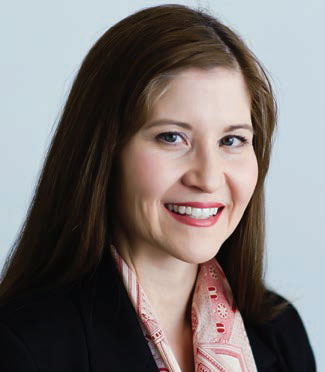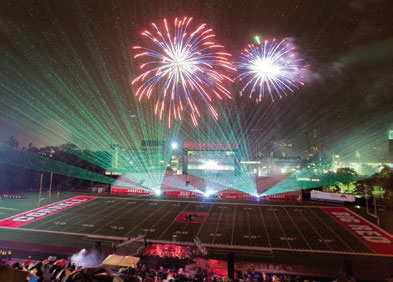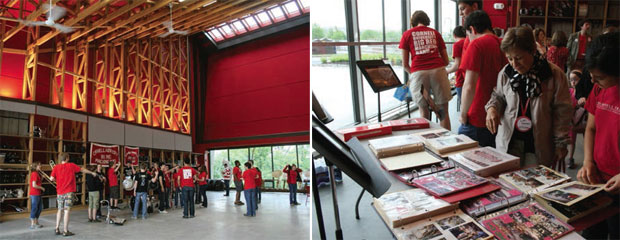A farewell from the outgoing CAA president
By Stephanie Keene Fox ’89
When I started on this journey two years ago, I knew that the Cornell Alumni Association was about to embark on a period of incredible change. I also knew I had been chosen to lead it through that change.
When I think of the CAA’s evolution, I compare it to building a house. There are three parts to the construction of our house. My predecessor, Nancy Abrams Dreier ’86, laid the foundation and we worked during her tenure to develop a vision for CAA.
My job was to build the walls. I needed to strengthen the organization by shifting our structure and culture— moving us from an honorary to a working board. Tremendous credit goes to our CAA board members and partners on the University staff for making it possible. Change is hard, especially when it comes to something as near and dear to our hearts as our relationship with Cornell.

Every decision we made was based on one fundamental goal: supporting Cornell. I became known for asking, “To what end?” In this way, we examined why we were doing things—and if we could do them in a way that better served the University’s needs. It was critical that we never lose sight of the reason we are connected: we are alumni of Cornell University. CAA’s purpose is to engage our alumni with the University and connect alumni with each other.
We’ve accomplished a lot, in two main areas: structure and culture. These changes have made CAA more effective as an organization. We were better able to support the expansion of Homecoming as a marquee event and to actively participate in the Cornell Alumni Leadership Conference. With our staff partners, we created a training track for regional club leaders. We supported participation in CALC by awarding scholarships. We created a “care package” program for regional clubs and a recognition system for outgoing club leaders. We wrote comprehensive descriptions for board positions. We created a new award, the CAA Cup, to recognize excellence in clubs, classes, and affinity groups.
CAA has done a wonderful job of recognizing top volunteers through the Frank H. T. Rhodes Exemplary Alumni Service Award. Each year, this award goes to up to six alumni who have given thirty-five or more years of service to the University. Rhodes Award recipients are among the treasures of our great university.
Throughout, we continued to support Cornell Alumni Magazine. We know an independent point of view is important to alumni. The magazine is owned by the CAA and thus journalistically independent of the University—one of the few among our peer institutions. However, the economics of the magazine are challenging as the publishing world continues to change. This needs to be an area of focus going forward.
Back to the building analogy: I think of the structure as the walls of our CAA house. The mortar that connects the walls to the foundation and keeps the bricks together is the culture of the CAA. Now that we have the foundation (vision) and walls (structure and culture change), we are ready to put up the roof.
Our next area of focus is branding our organization. Incoming president Kelly Smith Brown ’88, MBA ’92, has expertise in this area and is a perfect fit to lead us forward. Kelly will make sure the roof on our CAA house is watertight. We have already begun the branding conversation, and I am truly excited about the possibilities.
I look forward to spending more time with my family, now that my “Cornell job” is done. But it is bittersweet. I will miss the late-night calls with the executive committee and the camaraderie of board meetings. I have been on the board for fifteen years. During that time my family moved four times. I gave birth to four children. I lost my father and sister. Through it all, one of my anchors has been my relationship with Cornell, and I am grateful for that.
Wherever my family has lived or visited, Cornellians have welcomed us. It is still remarkable to me how passionate our alumni are about their alma mater. There is a bond that connects us across class years, affinities, areas of study, and geography. I think that is why being CAA president has been one of the most rewarding experiences of my life. It is a wonderful feeling to give back to something you love. It is a privilege.
It seems fitting to end this farewell letter with a final “To what end?” Why give time and talent to Cornell? We are incredibly fortunate to be alumni of one of the world’s great universities. The work Cornell does has true impact. From exploring Mars to supporting agriculture on our own planet—in every area of science and humanities, art and commerce—Cornell makes huge contributions. As alumni, you have an opportunity to be part of this. As alumni, it is your responsibility to be part of it.
Here is one thing I know: your connection to Cornell is one of the most lasting relationships you will have in your lifetime. It is worth investing in.
Cornell Boards Welcome New Leaders
The University’s major alumni groups have elected new leaders, whose terms began on July 1.
Cornell Alumni Association
Kelly Smith Brown ’88, MBA ’92, has been elected president of CAA. A former alumni-elected trustee, Brown will oversee a sixty-four-member board and work to define the CAA brand. Remaining as vice presidents are Laura Fratt ’81, Shana Chacko Mueller ’95, and Scott Pesner ’87. Bobby Tsai ’83 and Randy Rosenberg ’74 have joined the executive committee as vice presidents.
Seven new directors-from-the-region were elected to first terms. They are: Brad Grainger ’79 (Upstate New York/Ontario), Jennifer Ritter Kelly ’89 (Southeast), Michael Lee ’99 (Metro New York), Jeff MacCorkle ’88 (International), Sandy Robinson Torget ’94 (New England), Jay Treadwell ’61 (Mid-Atlantic), and Marilyn Yodlowski ’75 (Pacific). In addition, Marie-Jouvelle Aubourg ’06 (Metro New York) and Theresa Flores ’93 (Southwest) were elected to second terms.
Elected to first terms as directorsat- large were Shane Dunn ’07, Steven Flyer, JD ’91, Tom Pasniewski ’98, and Debbi Neyman Silverman ’85. Heather Knauss Wells ’02, Sam Pollack ’99, and Jonathan Simon ’92 were elected to second terms.
Cornell Association of Class Officers
Jay Waks ’68, JD ’71, has been elected president of CACO. Several board members will hold new positions as, or remain, vice presidents: Michael Avery ’55 and Paul Cashman ’73 (co-vice presidents— communications); Lauren Myers- Marion ’97 (vice president—diversity and inclusion); Simon Krieger ’76, MBA ’77 (vice president—leadership); Debbie Schaffel ’89 and Nancy Sverdlik ’79 (covice presidents—membership); and Charles Stuppard ’82 (vice president— students and young alumni).
In addition, ten new directors-at-large were elected to the board. They are: Bob Baca ’91, Jonelle Bradshaw de Hernandez ’96, Nancy Taylor Butler ’64, Lindsay Liotta Forness ’84, Carl Jones ’03, Anthony Lopez ’09, Amy Wang Manning ’90, Doug Mitarotonda ’02, PhD ’09, Stan Rodwin ’50, and Diana Tyler ’01.
Cornell University Council
Katrina James ’96 was elected to serve an additional one-year term as chair of the University Council. It is made up of Cornellians, parents, and friends who have shown exemplary leadership as alumni volunteers, in their professional lives, or in their communities. New vice chairs of the administrative board are Mary Maxon Grainger ’79, MPS ’87, and Jason McGill ’88. Jay Carter ’71, MEng ’72, and Teresa Port ’84 were elected to an additional term as vice chairs.
Joining the administrative board as elected members are Raj Chandnani ’95, Ronald Demer ’59, E. Eric Elmore ’86, JD ’89, Robert Everett ’65, Rosanna Romanelli Frank ’61, Lisa Barsanti Hoyt ’79, Susan Deitz Milmoe ’71, Tomoko Morinaga, MPS ’89, Reuben Munday ’69, MPS ’74, Christine Watters Stuhlmiller ’93, Margaret Mitchell Weingart ’78, and Frank Wilkinson ’84, BArch ’85.
President’s Council of Cornell Women
Jill Goldy, MS ’78, and Linda Gadsby ’88 have been elected co-chairs of PCCW. Its mission is to enhance the involvement of female students, faculty, staff, and alumnae as leaders within Cornell and its many communities.
Serving as committee chairs are Dianne Renwick ’82 (alumnae engagement), Daphne Mobley ’83 (annual meeting, Ithaca), Jeannette Perez-Rossello ’91 (annual meeting, New York), Elizabeth Ngonzi, MMH ’98 (communications), Eileen Weingarten ’75, BArch ’76 (development), Rita Redberg ’77 (diversity and inclusion), Laura Ericson Granger ’83 (grants), Theresa Brown-Edwards ’89 (membership), Sarah Emerson ’84 (mentoring), and Christine Stefanou Perry ’85 (transitions).
Homecoming: September 20–22

Finishing touches are being put on this year’s festivities. The events kick off on Friday evening, with the second annual Fireworks and Laser Light Showcase at Schoellkopf Field. The evening begins at 7:30 with music by local favorite DJ Double A and continues with a special Homecoming dance showcase featuring campusand Ithaca-based ensembles. The light show and fireworks display—which garnered rave reviews last year despite a rainstorm—will start at 8:45.
Saturday will bring an array of events, centered on the Cornell vs. Bucknell game, with kickoff at 3 p.m. Prior to that, the Big Red Fan Festival will be held throughout Kite Hill and the athletics areas, with food, music, and beer tents, plus free rides and games for the whole family. In addition, many fraternities, sororities, and affinity groups are planning events for their alumni.
The University is running special buses to transport attendees to campus from Boston, New York, and Washington, D.C. Also, alumni who pre-register for Homecoming will receive a special gift at check-in.
For more information, go to homecoming.cornell.edu.
Club Spotlight: Big Red Bands Alumni Association
At Homecoming, alumni of the Big Red Marching Band and Big Red Pep Band will gather for a big celebration: the dedication of a new practice facility behind Schoellkopf Crescent on Kite Hill. It was launched with a lead gift from former members David Fischell ’75, PhD ’80, and Sarah Thole Fischell ’78, MEN ’79, whose children were also in the band. The new facility will offer more practice and storage space—and move the bands out of their home of more than fifty years, a cramped room in Barton Hall.
The Big Red Bands Alumni Association (BRBAA) is almost done raising the $1 million it needed to build the facility— a major milestone in that organization’s history, which has long worked to provide financial support for both bands. The Alumni Association was founded in the early Eighties out of financial need for the marching band. “When I was a freshman in 1978, the music department told us that within three years they would stop financial support of the band,” says Stacey Hunt Montalto ’82. “For the next two years we tried all sorts of fundraising options, but it wasn’t enough.” When Montalto was elected student head manager in her junior year—and facing the band’s potential dissolution—she took a huge step. Gathering all the financial data she could find, she presented her case to the Department of Athletics as to why it should support the band. “They had a limited budget, but they were able to give us money, and we became associated with Athletics,” Montalto recalls. “We were also very lucky because the assistant in that office was Georgian Leonard, who loved the band and took us under her wing. For the next two decades, she would do whatever she could to support the band. It was all out of the goodness of her heart.”
But the Athletics funding wasn’t enough. Luckily, former drum major Dwight “Duke” Vicks II ’54, MBA ’57, entered the picture. His daughter, Cathy Vicks ’80, was serving as drum major during Montalto’s freshman year; son Dwight III ’84, MBA ’91, would eventually become drum major himself. Vicks saw the desperate times the band was facing and rallied his classmates. With the aim of providing ongoing financial support, the Big Red Bands Alumni Association was founded in 1982, with Vicks as president and Montalto as vice president. With Leonard’s help, BRBAA began to work with students to hold phonathons, reaching out to alumni to ask them to support the band. “It was probably the first time a student group pitched its alumni for a major financial undertaking,” Montalto says. “To this day, the students still do it. And they know that once they leave the band, they will be expected to support the band the same way, so there is a natural evolution and financial support has grown.”

However, BRBAA knew that phona thons would cover only annual operating expenses and not long-term needs such as instrument and uniform replenishment. So in the mid-Eighties, it created an endowment fund. Chaired by Vicks, the successful campaign was launched with a 1989 Carnegie Hall concert celebrating the retirement of the band’s longtime music advisor, Marice Stith.
BRBAA has also taken on an advisory role, helping to guide the student leadership of both bands. “There’s an important part of BRBAA that is almost as valuable as the financial aspects,” says current president Lowell Frank ’99, MD ’03, “and that’s the empowerment of the student leadership— whether it’s offering advice and experience, providing continuity over the years, or serving as a liaison between University units. It’s challenging at times, because our involvement will morph each year as different students are elected to leadership positions, but preserving the student-run nature of the band is very important.”
In addition, BRBAA helps make sure that alumni are connected with the band and to each other. Since 1981, former members have been invited to play on the field at halftime of the Homecoming game. BRBAA also hosts get-togethers at road games or when the pep band travels. “We’re trying to adapt our communications strategy to get information out to our alumni and supporters in a more timely manner, through an evolving Web presence and social media,” says Frank. “We are also cultivating our relationships within the University to improve communication on campus, and we’re working on more long-term financial planning.”
While the band has come a long way—from its original status within ROTC to the admittance of women in 1971 to the new facility on Kite Hill— there is nostalgia for times past. But alumni know things need to change. “Many of us will miss Barton Hall; small, cramped, under-ventilated quarters do lead to a lot of bonding,” says Frank. “Still, many of us alumni are a little bit jealous of their fantastic space and the larger symbolic role it can play for the students. Their time, dedication, spirit, and sweat do matter to Cornell— and they should know that the work they do is appreciated.”
The Big Red Bands facility dedication is set for 11:30 a.m. on the Saturday of Homecoming.


